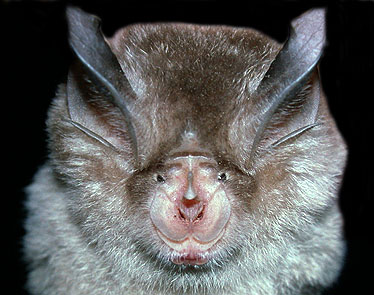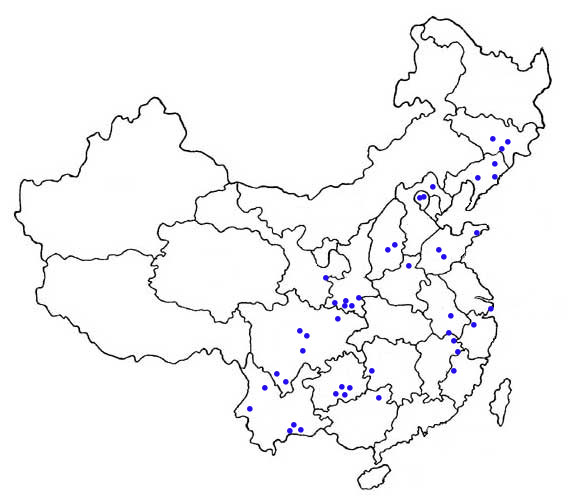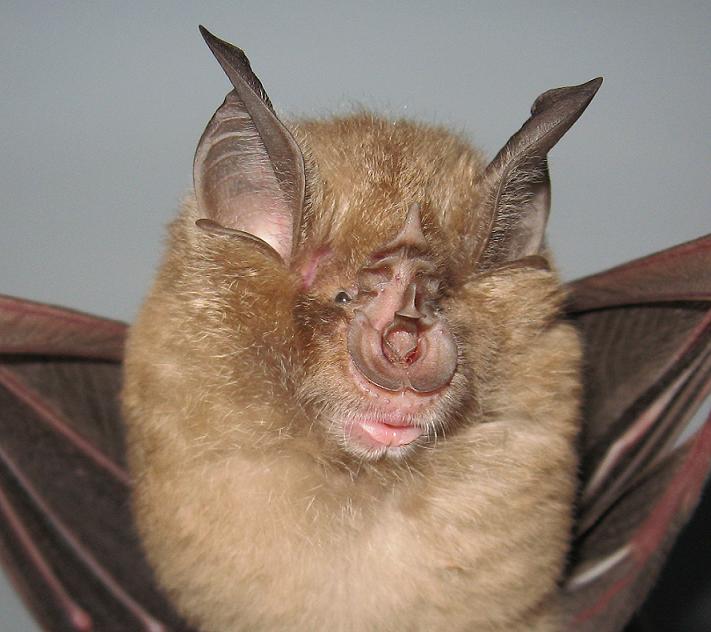Greater Horseshoe Bat
Morphological description Life history Distribution Habitat Roost sites and roosting patterns Emergence and flight pattern Foraging behaviour Echolocation calls Status and protection

Morphological Description
· Dorsal fur is buff with darker tips. Older adults may be darker and reddish (top photo).
· Juveniles are greyish (lower photo).
· A larger horseshoe bat. Average forearm length 53.0-62.5mm. (Csorba et al . 2003). Forearm lengths of bats we have caught in China are 58.4-61.4 mm (n = 12).
· The horseshoe is relatively narrow and dose not cover the whole muzzle. Sella is relatively small. The connecting process is high but bluntly rounded. The lancet is hastate, its tip generally long and slender. (Csorba et al . 2003)
· Body mass (as given by Greenaway & Hutson (1990) for UK) 13-34g. masses of bats in China 20.9-23.9 g (n = 3).
Life history
· Little known
Distribution
The Chinese distribution is shown by the dots on the map below (as given by Zhang et al . 1997).

Habitat
· Little known.
Roost sites and roosting behaviour
· This species often share their roosts with other bat species. In Sihe cave, Beijing suburb, it roosts with Myotis ricketti, Myotis chinensis, and Murina sp.
Emergence and flight pattern
· Most rhinolophid bats have wing shapes that make them adept at foraging in cluttered environments.
Foraging behaviour
· Analysis of droppings from Beijing area by GJ showed the diet to comprise (mean +/- SD, by volume) 96.9 +/- 9.4% Lepidoptera; 2.7 +/- 9.0% Coleoptera; traces of Diptera (12 bats, 5 droppings analysed/bat; bats captured 10-12 July). The diet therefore resembles that of R. ferrumequinum in the UK, where the species eats mainly moths and beetles (Jones 1990).
Echolocation calls
The echolocation call is a long constant frequency signal, with a brief frequency-modulated start and tail. Frequencies with most energy recorded from hand-held bats ranged between 74.8-77.1 kHz in Beijing (n = 18). One bat in Yunnan called with most energy at 72 kHz, and two in Sichuan at 72.2-73.8 kHz. These call frequencies are considerably lower than those emitted by R. ferrumequinum in Europe, which typically calls between 81-85 kHz (Heller & von Helversen 1989). The call frequencies also differ from R. ferrumequinum nippon in Japan which calls at close to 65 kHz (Taniguchi 1985; Fukui et al. 2004).
To listen to the call of the greater horseshoe bat click here
Size of sound file: 1.2 Mb
Chinese R. ferrumequinum have a very complex repertoire of calls other than echolocation calls that they use in vocal communication (Ma et al. 2006). Calls could be classified into 17 syllable types that could be combined into simple phrases and combination phrases. Most of the vocalizations are ultrasonic, although some are audible to humans.
Status and protection
· There is no estimation of population size in China.
· Greater horseshoe bats are LR/nt, assessed by the Red List of Threatened Species (IUCN, 2006) The species is not listed in the Law of the People's Republic of China on the Protection of Wildlife in 1989.
· Caves should be protected as their habitats.
